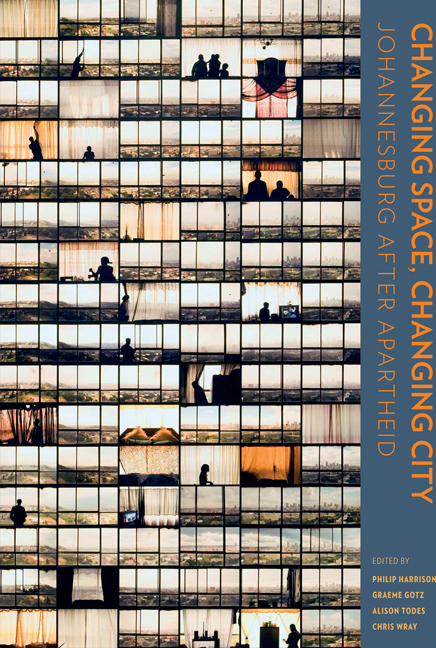Book contents
- Frontmatter
- Contents
- Preface
- Cartography
- 1 Materialities, subjectivities and spatial transformation in Johannesburg
- Section A The macro trends
- Section B Area-based transformations
- 12 Between fixity and flux: Grappling with transience and permanence in the inner city
- 13 Are Johannesburg's peri-central neighbourhoods irremediably ‘fluid’? Local leadership and community building in Yeoville and Bertrams
- 14 The wrong side of the mining belt? Spatial transformations and identities in Johannesburg's southern suburbs
- 15 Soweto: A study in socio-spatial differentiation
- 16 Kliptown: Resilience and despair in the face of a hundred years of planning
- 17 Alexandra
- 18 Sandton Central, 1969–2013: From open veld to new CBD?
- 19 In the forest of transformation: Johannesburg's northern suburbs
- 20 The north-western edge
- 21 The 2010 World Cup and its legacy in the Ellis Park Precinct: Perceptions of local residents
- 22 Transformation through transportation: Some early impacts of Bus Rapid Transit in Orlando, Soweto
- Section C Spatial identities
- Contributors
- Photographic credits
- Acronyms
- List of plates
- List of figures
- List of tables
- Index
18 - Sandton Central, 1969–2013: From open veld to new CBD?
from Section B - Area-based transformations
Published online by Cambridge University Press: 20 April 2018
- Frontmatter
- Contents
- Preface
- Cartography
- 1 Materialities, subjectivities and spatial transformation in Johannesburg
- Section A The macro trends
- Section B Area-based transformations
- 12 Between fixity and flux: Grappling with transience and permanence in the inner city
- 13 Are Johannesburg's peri-central neighbourhoods irremediably ‘fluid’? Local leadership and community building in Yeoville and Bertrams
- 14 The wrong side of the mining belt? Spatial transformations and identities in Johannesburg's southern suburbs
- 15 Soweto: A study in socio-spatial differentiation
- 16 Kliptown: Resilience and despair in the face of a hundred years of planning
- 17 Alexandra
- 18 Sandton Central, 1969–2013: From open veld to new CBD?
- 19 In the forest of transformation: Johannesburg's northern suburbs
- 20 The north-western edge
- 21 The 2010 World Cup and its legacy in the Ellis Park Precinct: Perceptions of local residents
- 22 Transformation through transportation: Some early impacts of Bus Rapid Transit in Orlando, Soweto
- Section C Spatial identities
- Contributors
- Photographic credits
- Acronyms
- List of plates
- List of figures
- List of tables
- Index
Summary
By the time Johannesburg was a mere 40 years old it was being hailed as a ‘world city’ (MacDonald 1926: 9). By 1936 when it celebrated its 50th ‘birthday’ the accolade was even more appropriate. In large measure its status was promoted by the sophistication of its central business district, or CBD, one that had largely been rebuilt following the massive investment that had flowed into it after December 1932 when South Africa abandoned the gold standard in favour of a market price for the precious metal (Hobart Houghton and Dagut 1973). Notwithstanding some early signs of decentralisation to the suburbs in 1959 (Lauf 1959), the CBD was still the paramount location for business in the tower-block phase that characterised the 1970s. At the time few people would have thought that the decision to build a large but isolated mall and office tower called Sandton City on a piece of open veld in a neighbouring and infant municipality called Sandton would constitute a real threat to Johannesburg's CBD. Certainly no one could have conceived that, just three decades later, Sandton City would have grown and attracted so many additional businesses as to become effectively the new CBD of the greatly enlarged unicity of Johannesburg. Indeed, by virtue of this status, Sandton Central is arguably the premier business district on the African continent (Beavon 2004; CDE 2002). The building of Sandton City has been identified as the single most important development in marking ‘the beginning of the end for the [Johannesburg] CBD’ (Daniels 2000).
The decline of the old CBD and the spread of office nodes in the wake of the everwidening fan of major malls in Johannesburg's northern suburbs have been the focus of attention elsewhere (Beavon 2000a, 2004, 2005; Beavon and Larsen 1998; Goga 2003; Tomlinson 1999; Tomlinson and Larsen 2003). Yet very little is known about the way in which the Sandton node developed and grew and, in theoretical terms, became for a brief moment another example, and probably the first South African one, of what has been identified in the USA as an ‘edge city’ (Badenhorst 2002; Garreau 1991). Consequently, in this chapter we focus on these two aspects, that is: the emergence and development of the Sandton business node, as well as its present character, extent and status.
- Type
- Chapter
- Information
- Changing Space, Changing CityJohannesburg after apartheid, pp. 370 - 394Publisher: Wits University PressPrint publication year: 2014



